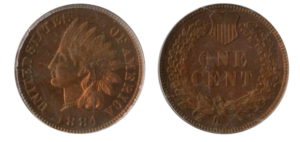1884 Indian Head Penny: A Tangible Piece of Early American History
Posted onDuring the economic chaos of the Civil War, Americans hoarded any precious metal they could find. Even copper-nickel one-cent pieces virtually disappeared from circulation. The U.S. government came to the rescue with the Act of April 22 and authorized a new thin, bronze version of the Indian Head penny.
Indian Head pennies are an iconic, classic early American coin coveted by collectors. Minted from 1859 through 1909, Indian Head cents surged in popularity in the post-war era and were produced in large numbers in most years.
The exception is 1877 when a weak American economy decreased demand for new coinage, and only 852,500 Indian Head cents were minted, making it one of the rarest dates in the series. However, as coin operated machines became popular in the late 19th and early 20th centuries, the need for even more for Indian head pennies jumped and production topped 100 million in 1907.
Curious about this stunning early American coin? Blanchard has one 1884 Indian Head cent proof on offer. See it here. The 1884 Indian Head cent proofs had a tiny mintage totaling 3,942. Survivors are extremely scarce and hard to find. Like most Indian Head pennies, this proof coin from 1884 has seen its value climb in recent years, due primarily to the innate scarcity for a coin minted 140 years ago.
James Barton Longacre the Chief Engraver at the Philadelphia Mint designed this arresting early American coin, minted in Philadelphia. Longacre made his case for the new design featuring Lady Liberty in a traditional Native American headdress in a passionate letter to the director of the U.S. Mint James Snowden:
“From the copper shores of Lake Superior, to the silver mountains of Potosi from the Ojibwa to the Aramanian, the feathered tiara is as characteristic of the primitive races of our hemisphere, as the turban is of the Asiatic. Nor is there anything in its decorative character, repulsive to the association of Liberty … It is more appropriate than the Phrygian cap, the emblem rather of the emancipated slave, than of the independent freeman, of those who are able to say “we were never in bondage to any man”. I regard then this emblem of America as a proper and well defined portion of our national inheritance; and having now the opportunity of consecrating it as a memorial of Liberty, ‘our Liberty’, American Liberty; why not use it? One more graceful can scarcely be devised. We have only to determine that it shall be appropriate, and all the world outside of us cannot wrest it from us.”
The Indian Head penny features Lady Liberty on the obverse wearing a traditional Native American headdress. The design generated controversy as it appears that Lady Liberty is a Caucasian woman wearing a Native American headdress. In fact, legends claim the model for the coin is actually James Longacre’s daughter, Sarah! The handsome coin’s reverse features a lovely oak wreath with arrows at bottom and a shield at top.
1884 was an exciting time in American history. Imagine the stories this 140-year old Indian Head penny could tell!
In that year, a proclamation for the eight-hour workday in the United States was demanded by the Federation of Organized Trades and Labor Unions. In May 1884, Alaska became a U.S. territory. In July of that year, Dow Jones published its first stock market index: The Dow Jones Transportation Average, which is the oldest stock index still in use today.
In August, the cornerstone for the Statue of Liberty was laid on Bedloe’s Island in New York Harbor. In November, Democratic Governor of New York Grover Cleveland beat Republican James G. Blaine in a very close presidential election contest. In December, the Washington Monument was completed in Washington, D.C., which was the tallest structure in the world at that time.
Last but not least, in December, Mark Twain’s classic Adventures of Huckleberry Finn was first published in 1884.
In 1909, the Indian Head cent was replaced by the Lincoln cent, designed by Victor D. Brenner, closing an important era in U.S. numismatic history.
Want to read more? Subscribe to the Blanchard Newsletter and get our tales from the vault, our favorite stories from around the world and the latest tangible assets news delivered to your inbox weekly.







